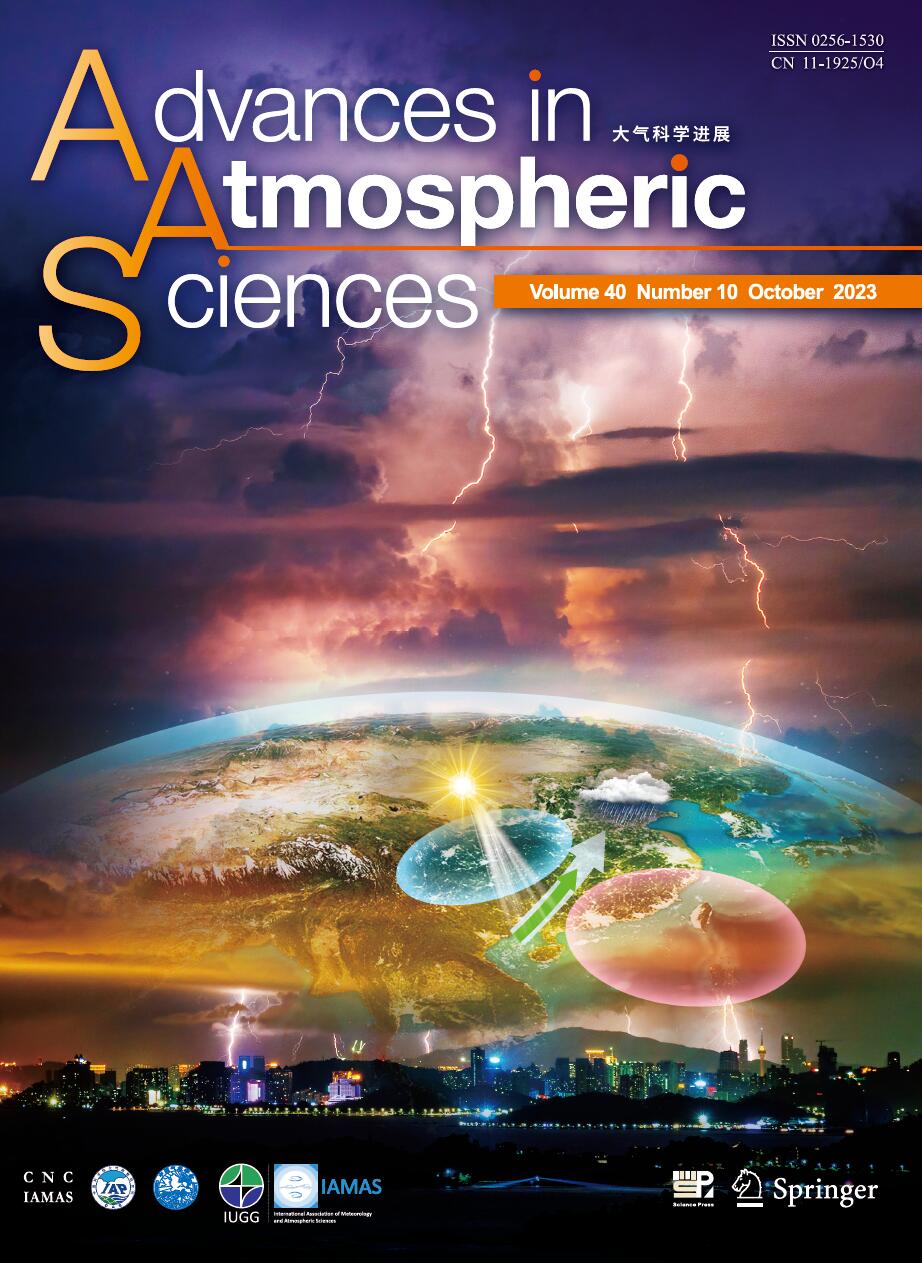| [1] |
S. PANCHEV, T. SPASSOVA,
2005: Simple General Atmospheric Circulation and Climate Models with Memory, ADVANCES IN ATMOSPHERIC SCIENCES, 22, 765-769.
doi: 10.1007/BF02918720
|
| [2] |
Shutao CHEN, Jianwen ZOU, Zhenghua HU, Yanyu LU,
2019: Climate and Vegetation Drivers of Terrestrial Carbon Fluxes: A Global Data Synthesis, ADVANCES IN ATMOSPHERIC SCIENCES, , 679-696.
doi: 10.1007/s00376-019-8194-y
|
| [3] |
Susannah M. BURROWS, Aritra DASGUPTA, Sarah REEHL, Lisa BRAMER, Po-Lun MA, Philip J. RASCH, Yun QIAN,
2018: Characterizing the Relative Importance Assigned to Physical Variables by Climate Scientists when Assessing Atmospheric Climate Model Fidelity, ADVANCES IN ATMOSPHERIC SCIENCES, 35, 1101-1113.
doi: 10.1007/s00376-018-7300-x
|
| [4] |
Tido SEMMLER, Thomas JUNG, Marta A. KASPER, Soumia SERRAR,
2018: Using NWP to Assess the Influence of the Arctic Atmosphere on Midlatitude Weather and Climate, ADVANCES IN ATMOSPHERIC SCIENCES, 35, 5-13.
doi: 10.1007/s00376-017-6290-4
|
| [5] |
JIANG Dabang, DING Zhongli, Helge DRANGE, GAO Yongqi,
2008: Sensitivity of East Asian Climate to the Progressive Uplift and Expansion of the Tibetan Plateau Under the Mid-Pliocene Boundary Conditions, ADVANCES IN ATMOSPHERIC SCIENCES, 25, 709-722.
doi: 10.1007/s00376-008-0709-x
|
| [6] |
Odd Helge OTTERA,
2008: Simulating the Effects of the 1991 Mount Pinatubo Volcanic Eruption Using the ARPEGE Atmosphere General Circulation Model, ADVANCES IN ATMOSPHERIC SCIENCES, 25, 213-226.
doi: 10.1007/s00376-008-0213-3
|
| [7] |
ZHENG Xunhua, LIU Chunyan, HAN Shenghui,
2008: Description and Application of a Model for Simulating Regional Nitrogen Cycling and Calculating Nitrogen Flux, ADVANCES IN ATMOSPHERIC SCIENCES, 25, 181-201.
doi: 10.1007/s00376-008-0181-7
|
| [8] |
Ding Aiju, Wang Mingxing,
1996: Model for Methane Emission from Rice Fields and Its Application in Southern China, ADVANCES IN ATMOSPHERIC SCIENCES, 13, 159-168.
doi: 10.1007/BF02656859
|
| [9] |
Zhao Li, Zhao Sixiong,
1995: Numerical Experiments of Meiyu(Baiu) Rainfall by Quasi-Lagrangian Limited Area Model with Terrain, ADVANCES IN ATMOSPHERIC SCIENCES, 12, 57-66.
doi: 10.1007/BF02661287
|
| [10] |
DUAN Anmin, WU Guoxiong, LIU Yimin, MA Yaoming, ZHAO Ping,
2012: Weather and Climate Effects of the Tibetan Plateau, ADVANCES IN ATMOSPHERIC SCIENCES, 29, 978-992.
doi: 10.1007/s00376-012-1220-y
|
| [11] |
Mu Mu, Duan Wansuo, Wang Jiacheng,
2002: The Predictability Problems in Numerical Weather and Climate Prediction, ADVANCES IN ATMOSPHERIC SCIENCES, 19, 191-204.
doi: 10.1007/s00376-002-0016-x
|
| [12] |
FAN Lei, Zhengyu LIU, LIU Qinyu,
2011: Robust GEFA Assessment of Climate Feedback to SST EOF Modes, ADVANCES IN ATMOSPHERIC SCIENCES, 28, 907-912.
doi: 10.1007/s00376-010-0081-5
|
| [13] |
Lijing CHENG, John ABRAHAM, Kevin E. TRENBERTH, Tim BOYER, Michael E. MANN, Jiang ZHU, Fan WANG, Fujiang YU, Ricardo LOCARNINI, John FASULLO, Fei ZHENG, Yuanlong LI, Bin ZHANG, Liying WAN, Xingrong CHEN, Dakui WANG, Licheng FENG, Xiangzhou SONG, Yulong LIU, Franco RESEGHETTI, Simona SIMONCELLI, Viktor GOURETSKI, Gengxin CHEN, Alexey MISHONOV, Jim REAGAN, Karina VON SCHUCKMANN, Yuying PAN, Zhetao TAN, Yujing ZHU, Wangxu WEI, Guancheng LI, Qiuping REN, Lijuan CAO, Yayang LU,
2024: New Record Ocean Temperatures and Related Climate Indicators in 2023, ADVANCES IN ATMOSPHERIC SCIENCES.
doi: 10.1007/s00376-024-3378-5
|
| [14] |
DONG Wenjie, CHOU Jieming, FENG Guolin,
2007: A New Economic Assessment Index for the Impact of Climate Change on Grain Yield, ADVANCES IN ATMOSPHERIC SCIENCES, 24, 336-342.
doi: 10.1007/s00376-007-0336-y
|
| [15] |
ZHOU Feifan, DING Ruiqiang, FENG Guolin, FU Zuntao, DUAN Wansuo,
2012: Progress in the Study of Nonlinear Atmospheric Dynamics and Predictability of Weather and Climate in China (2007--2011), ADVANCES IN ATMOSPHERIC SCIENCES, 29, 1048-1062.
doi: 10.1007/s00376-012-1204-y
|
| [16] |
MU Mu, DUAN Wansuo, XU Hui, WANG Bo,
2006: Applications of Conditional Nonlinear Optimal Perturbation in Predictability Study and Sensitivity Analysis of Weather and Climate, ADVANCES IN ATMOSPHERIC SCIENCES, 23, 992-1002.
doi: 10.1007/s00376-006-0992-3
|
| [17] |
Yun QIAN, Teppei J. YASUNARI, Sarah J. DOHERTY, Mark G. FLANNER, William K. M. LAU, MING Jing, Hailong WANG, Mo WANG, Stephen G. WARREN, Rudong ZHANG,
2015: Light-absorbing Particles in Snow and Ice: Measurement and Modeling of Climatic and Hydrological impact, ADVANCES IN ATMOSPHERIC SCIENCES, 32, 64-91.
doi: 10.1007/s00376-014-0010-0
|
| [18] |
Chen Yuejuan, Zhang Hong, Bi Xunqiang,
1998: Numerical Experiment for the Impact of the Ozone Hole over Antarctica on the Global Climate, ADVANCES IN ATMOSPHERIC SCIENCES, 15, 300-311.
doi: 10.1007/s00376-998-0002-z
|
| [19] |
WANG Aihui, ZENG Xubin,
2009: Improving the Treatment of the Vertical Snow Burial Fraction over Short Vegetation in the NCAR CLM3, ADVANCES IN ATMOSPHERIC SCIENCES, 26, 877-886.
doi: 10.1007/s00376-009-8098-3
|
| [20] |
ZHAO Haikun, WU Liguang, ZHOU Weican,
2010: Assessing the Influence of the ENSO on Tropical Cyclone Prevailing Tracks in the Western North Pacific, ADVANCES IN ATMOSPHERIC SCIENCES, 27, 1361-1371.
doi: 10.1007/s00376-010-9161-9
|















 AAS Website
AAS Website 
 AAS WeChat
AAS WeChat 
 DownLoad:
DownLoad: